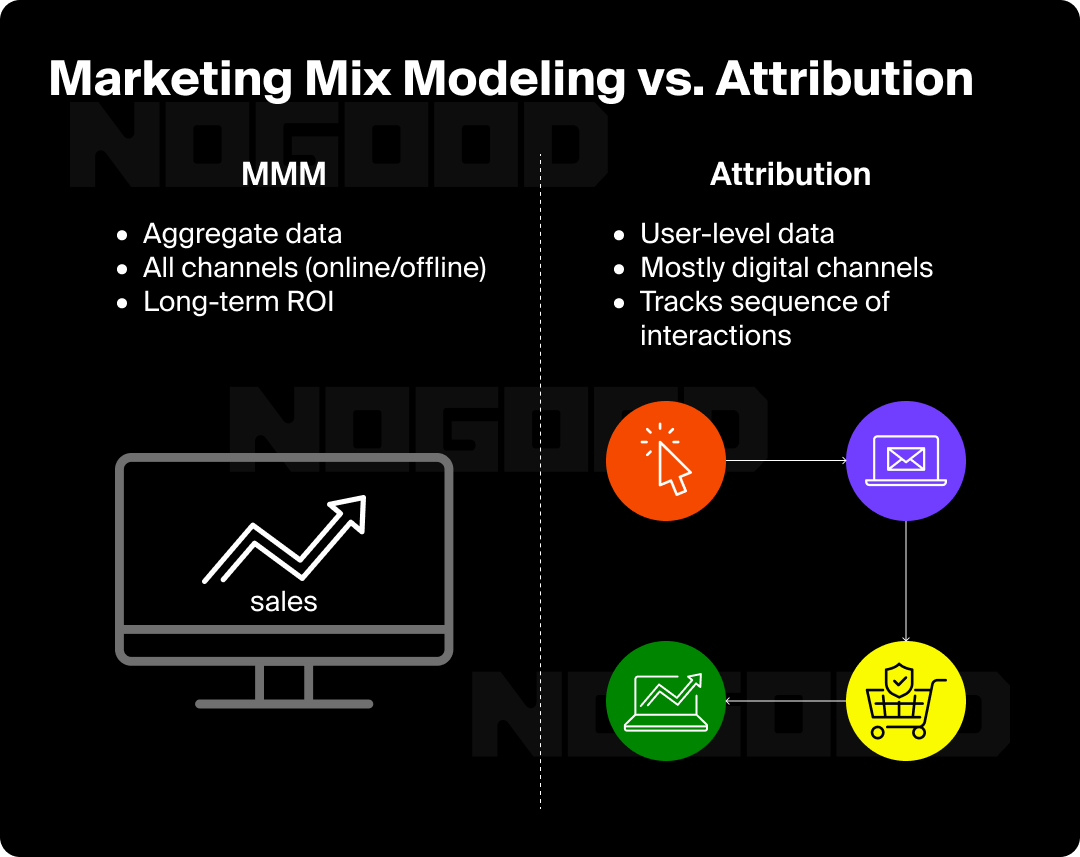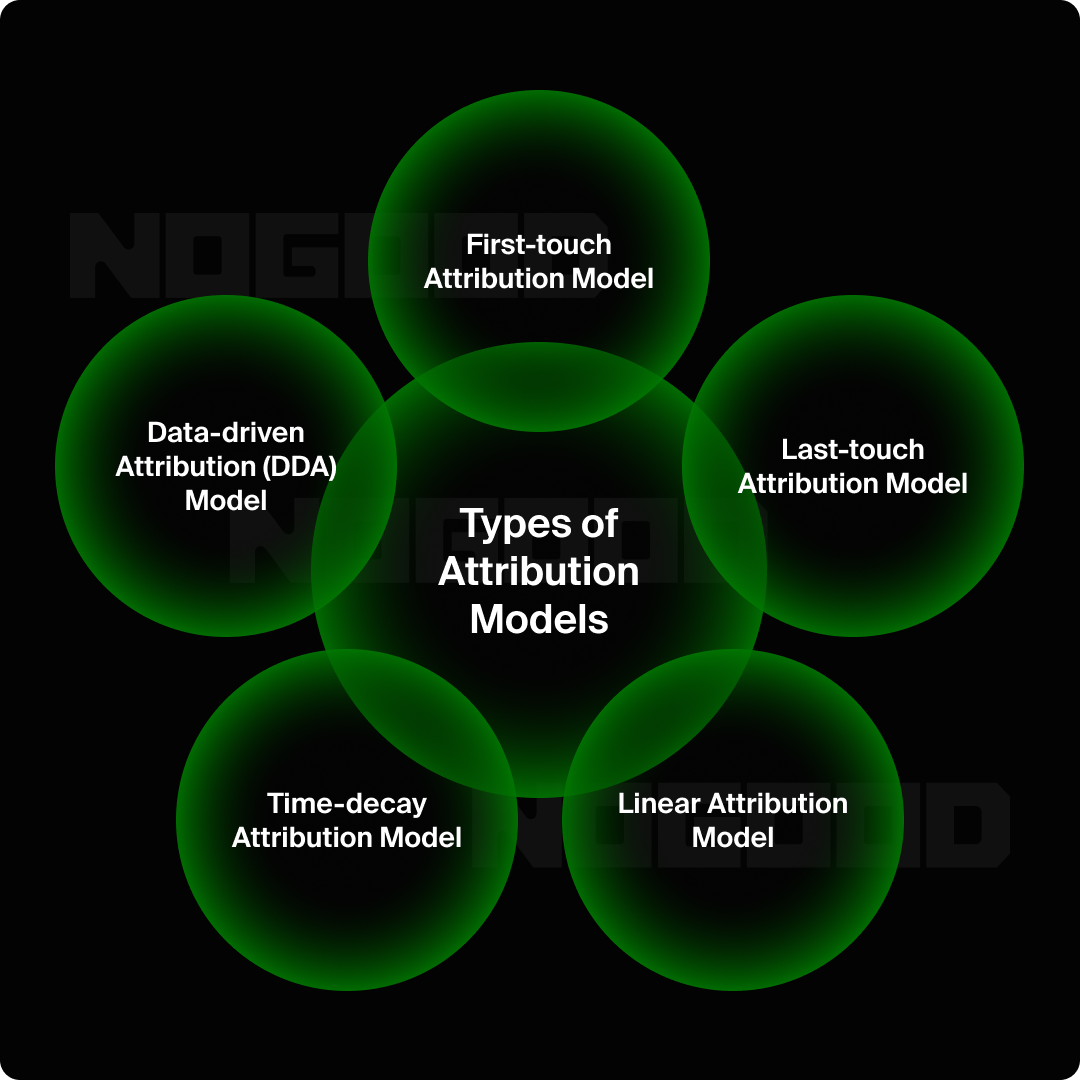In the data-driven marketing world we all live in, we have more performance metrics than we know what to do with. Attribution modeling zooms in on specific touchpoints in a customer journey, while marketing mix modeling zooms out to see the big picture of all our marketing efforts. Both approaches help answer the following: “Which of our marketing activities are actually driving results?” But they do it in very different ways.
In this blog, I’ll break down what each method is, key differences between marketing mix modeling and attribution, and give honest recommendations on when to use each; or even both together. By the end, you’ll have a clearer picture of which approach fits your needs.
What Is Marketing Mix Modeling (MMM)?
Marketing mix modeling (also referred to as MMM or media mix modeling) is a top-down statistical analysis technique that evaluates the impact of different marketing inputs on an outcome (usually sales or conversions) over time. Essentially, MMM looks at historical aggregate data—your budgets, marketing channels, campaigns, and even external factors—and finds patterns to determine how each element contributed to results.
It’s basically a “big picture” regression analysis of all your marketing data: MMM can tell you, for example, how much your TV ads, paid search, social media, email campaigns, pricing changes, and even seasonality each moved the needle on sales.
Unlike attribution models that focus on individual customer journeys, MMM assesses omni-channel performance at a high level. It takes into account offline channels and online channels together, along with external variables such as economic conditions, weather, or competitor actions. By doing so, MMM can estimate the incremental impact of each marketing channel or tactic. In other words, how much extra sales or lift you got because of that marketing spend, beyond your baseline sales. This provides a holistic view of ROI across all channels.
Key Point: MMM does not track individual users or require personal data. It works with aggregated information and doesn’t need to follow a customer’s every click. This means MMM is naturally privacy friendly, which is a big plus in today’s world of strict privacy regulations. With GDPR and CCPA being able to measure marketing without user level tracking is invaluable.
Benefits & Limitations of Marketing Mix Modeling
The Good Stuff
MMM’s big selling point is the holistic, strategic insight it offers. It considers all marketing touchpoints and even non marketing factors in one model. This helps you answer high level questions like, “what’s the optimal allocation of my marketing budget across channels?” or, “How much should I invest in Brand Awareness vs. Direct Response advertising next year?”
If you want to measure return on investment for each marketing channel or find your marketing mix’s effect on key performance indicators, like sales or market share, MMM is your go-to. It’s also great for forecasting and scenario planning and running “what-if” simulations to predict outcomes if you increase spend on one channel and cut another.
The Limitations
However, MMM is not without its challenges. Classic MMM requires a lot of data over a long period to get reliable results; usually 2 to 3+ years, depending on how granular your time periods are. If you’re a smaller business or a startup without much historical data or with a modest marketing budget, a full MMM might not yield meaningful insights yet.
Additionally, building and maintaining an MMM can be resource intensive. You need analytics to know how to gather and clean data from all sources, run the models, and interpret results. It’s not as plug-and-play as some digital analytics dashboards. Also, MMM typically updates slowly, so it’s not ideal for day to day campaign optimizations or quick feedback. It gives strategic direction more so than tactical guidance.

What Is Attribution Modeling?
Attribution modeling is a bottom-up approach that tries to answer: “Which touchpoints in a customer’s journey deserve credit for the conversion?” In other words, it examines all the marketing touchpoints a single customer interacts with on the way to a purchase and assigns credit or weight to each of those touchpoints. If MMM is our wide angle lens, attribution is our zoom lens on one customer’s path.
The appeal of attribution modeling is that it connects the dots in near real-time for digital marketing efforts. It helps answer which ads, keywords, or content contributed to a sale, and by how much. For instance, If data gathered via attribution modeling shows that your email campaigns are getting 30% of the credit for online sales, you might invest more in email marketing or adjust your strategy accordingly.

Types of Attribution Models
A classic example we can use to explore the types of attribution models is a customer who sees a Google search ad, then clicks a Facebook ad, then receives an email, and finally makes a purchase. Attribution modeling asks which of these touches gets credit for that sale—the first ad, the last email, or something in between? Different attribution models answer differently:
- A first-touch attribution model would give 100% credit to the Google search ad.
- A last-touch attribution model would give all credit to the final email.
- A linear attribution model would split credit equally among all three touches.
- A time-decay attribution model would give more credit to touches closer to the conversion.
- A data-driven attribution (DDA) model would give credit based on observed user behavior (parsed using a machine learning model).
These are the core attribution models, but there are many more out in the world, each with its own logic, including platform-specific ones like Facebook or Google Analytics’ default models and custom rule-based models.
In order to examine the difference between marketing mix modeling and attribution modeling, we’ll need to specify the type of attribution modeling we’re talking about. If you’re looking to decide between MMM and data attribution, it’s safe to assume that you also have the resources and technology to undertake a more advanced attribution model—so we’ll use data-driven attribution for our comparison.
The Difference Between Marketing Mix Modeling & Attribution Modeling
It’s worth clarifying MMM vs. DDA, since “data-driven attribution” comes up a lot. Data-driven attribution (DDA) is a type of attribution modeling. It uses machine learning on user-level journey data to assign fractional credit to marketing touchpoints based on their observed influence on conversions.
In plain terms, DDA looks at patterns, such as “users who saw the Instagram ad and the email are 50% more likely to buy than those who only saw the email”, and adjusts credit split accordingly. This is far more dynamic than the rule-based models we talked about earlier.
Comparing MMM and DDA directly:
- Marketing mix modeling uses aggregated, historical data (i.e. monthly spends and sales) and statistical regression to find each channel’s contribution to overall results. It covers online, offline, and external factors, giving a macro level view of total marketing impact.
- Data-driven attribution uses user-centric data and algorithmic modeling to attribute portions of a single conversion to different touches. It’s limited to trackable digital touchpoints and gives a micro-level view of how interactions influence a single customer’s decision.
When to Use Marketing Mix Modeling, Attribution Modeling, or Both
So, which should you use: MMM or attribution? They serve different purposes, and many organizations benefit from using both in tandem. Here’s a strategic take:
When to Use Marketing Mix Modeling
Use marketing mix modeling when:
- You need a holistic, cross-channel view of marketing effectiveness, including offline channels or non-digital tactics. For example, if your marketing spans TV, radio, print, in-store, and online, an MMM is ideal to measure everything on a common ROI basis.
- You want to base big-budget decisions on data. MMM will inform how to allocate your marketing budget across channels for the best return on investment.
- Privacy is a major concern or tracking is incomplete. If you operate in a space with limited user tracking (financial services, healthcare, EU markets, etc.), MMM can fill the measurement void because it doesn’t rely on personal data or cookies.
Here’s an example scenario: A CMO of a retail brand is planning next year’s marketing budget. He uses MMM to discover that paid search and TV ads drive the highest incremental sales per dollar, so she shifts more budget there and less on a low impact channel.
When to Use Attribution Modeling (MTA / DDA)
Here are some examples of when you might want to use data-driven attribution or multi-touch attribution (MTA) over marketing mix modeling:
- You’re focused on digital marketing optimization and need quick feedback. If you run lots of online campaigns (search, social, email, display), attribution helps identify which ads, keywords, or audience segments are contributing to conversions so you can tweak campaigns in near real time.
- The customer journey for your offering is primarily online and trackable. If you operate an eCommerce site with marketing mostly in digital channels, attribution will cover much of the journey.
Let’s use another example scenario: A growth marketer at a SaaS startup uses multi-touch attribution in Google Analytics to see that their Google Ads and Facebook Ads tend to assist each other. Customers often click a Facebook ad, then at a later time, perform search and click a Google ad before fully converting via their website. This insight leads them to continue investing in both channels for a combined effect, rather than cutting one prematurely.
When to Use Both Marketing Mix Modeling & Attribution
I know we just went over the scenarios for each, but the truth is, increasingly, the answer to marketing vs. attribution is to do both. After all, they complement each other’s blind spots. MMM gives the big-picture truth of what drives sales overall, while attribution provides granular guidance for day-to-day execution.
For instance, a marketing team might use MMM results to set high-level budgets for each channel at the start of the quarter. Then, within each channel, they use attribution data to optimize which campaigns or ads to push. The MMM is like the strategic map, and attribution is like the turn-by-turn directions.
Future-Focused Insights: AI & Privacy in Marketing Measurement
No discussion of marketing analytics in 2025 is complete without mentioning two game-changers: artificial intelligence and privacy regulations. Both are reshaping how we approach marketing mix modeling and attribution.
On the AI front, we’re seeing the rise of AI-powered marketing mix modeling that promises to make MMM faster, more granular, and more accessible. Traditional MMM was slow and infrequent. But now, thanks to machine learning and cloud computing, new tools can update MMM models far more quickly and even approach something like real time optimization. Automated MMM platforms can ingest data continuously and spit out insights on the fly, helping marketers adjust their spend allocations much more often than the old annual review.
For example, there are AI driven MMM solutions that simulate and recommend optimal budget allocations across channels every week or month, adapting to new data. Modern “next-generation MMMs” using advanced ML can even optimize spend between campaigns daily, blurring the line between MMM and in-campaign attribution-style optimization.
Conclusion
Choosing between marketing mix modeling vs. attribution modeling isn’t an “either-or” dilemma. It’s about picking the right tool for the job.
Marketing mix modeling gives you broad, strategic insight across all channels and thrives in today’s privacy-conscious landscape. Attribution modeling provides granular, tactical insight into the customer journey and excels in optimizing digital campaigns. If you’re looking at long term budget allocation or measuring total return on ad spend across every channel, MMM is the tool. If you need to fine tune your Google Ads versus Facebook Ads spend this week, attribution is the way to go.
Keep in mind, though—with the rise of AI and the push for privacy, these models are evolving and even converging. The future of marketing analytics will be about blending methodologies to get the most accurate insights. By understanding what MMM and attribution offer, you can craft a measurement strategy that is both data driven and future proof, guiding your marketing decisions with confidence in a rapidly changing environment.





